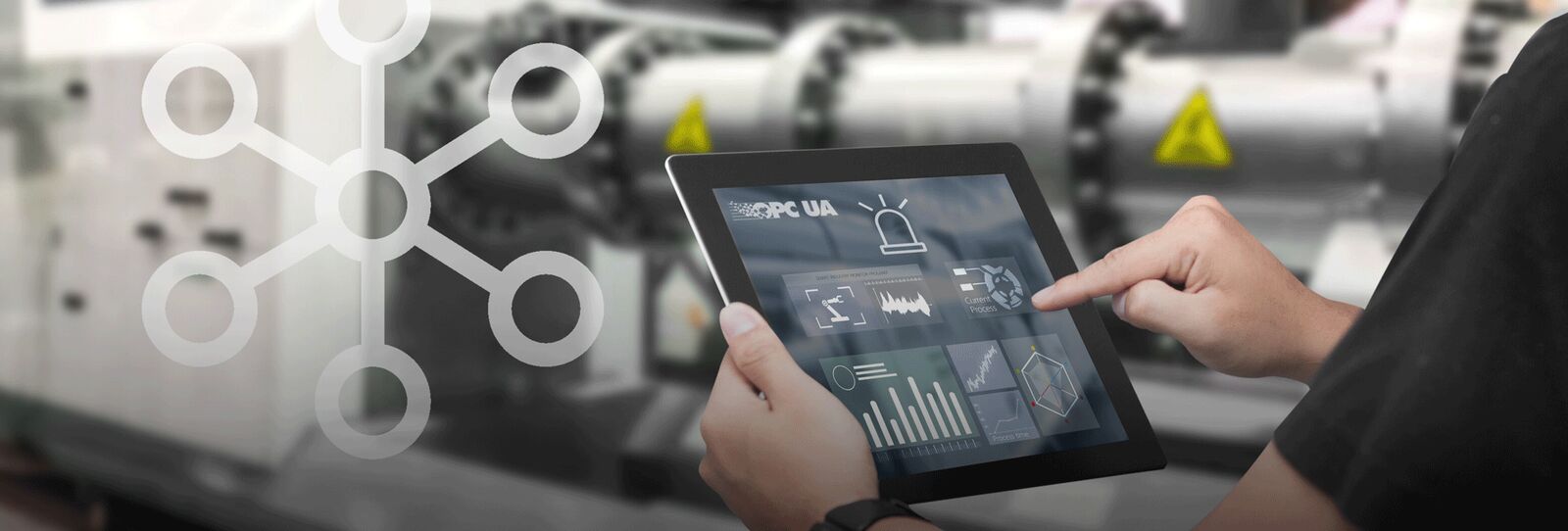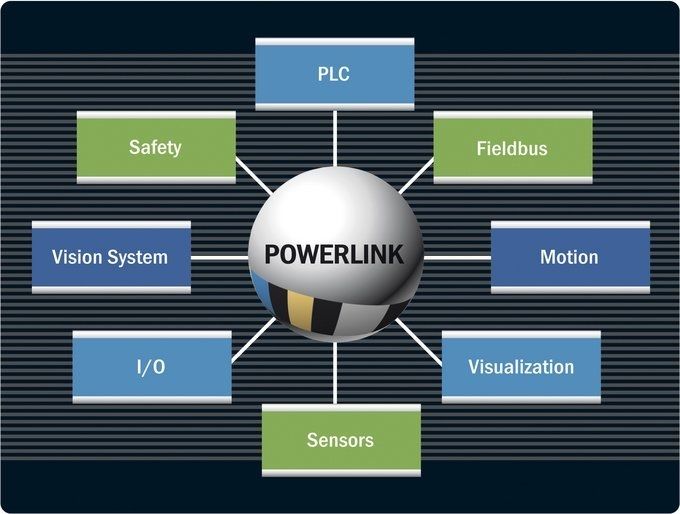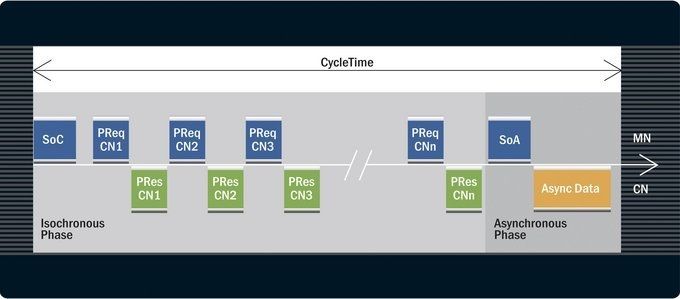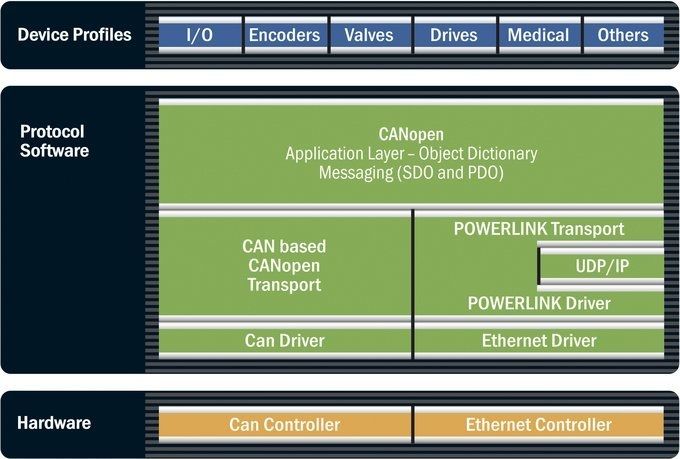
One network for all systems
POWERLINK is an industrial Ethernet solution designed to give users a single, consistent and integrated means for handling all communication tasks in modern automation. It is generally suitable for all conceivable applications in machine and plant engineering as well as for process industry applications.
A POWERLINK network integrates all components in industrial automation, such as PLCs, sensors, I/O modules, motion controllers, safety controls, safety sensors and actuators, and HMI systems. A POWERLINK cycle not only accommodates transmissions of actual payload data for applications, but also provides a fixed time slot reserved for transfers of miscellaneous user data in its asynchronous phase.
As a result, data that is not time-critical can also be transmitted, e.g. service data, to enable the remote maintenance and configuration of a device. Likewise, devices that do not belong to the immediate automation level can be included in the network environment as well, e.g. in the case of video cameras for site surveillance and access control.
Moreover, a proper gateway also allows for the transmission of other, non-POWERLINK fieldbus data within the asynchronous part of a cycle, i.e. the protocol enables the integration of various types of networks.

Based on standard Ethernet
Based on standard Ethernet
The decision to standardize a technology fully compliant with IEEE 802.3 is a safe choice for the future. POWERLINK will benefit from the long-term evolution of Ethernet technology without requiring further investment. POWERLINK fully supports standard TCP/IP protocols. Because TCP/IP runs on a dedicated communication channel, it ensures guaranteed bandwidth for TCP/IP without impacting hard real-time data exchange.
The EPSG decision to standardize a technology fully compliant with IEEE 802.3 is a safe choice for the future. POWERLINK will benefit from the long-term evolution of Ethernet technology without requiring further investment. POWERLINK fully supports standard TCP/IP protocols. Because TCP/IP runs on a dedicated communication channel, it ensures guaranteed bandwidth for TCP/IP without impacting hard real-time data exchange.
Absolute openness
Absolute openness
POWERLINK was released in 2003 as an international standard by the independent Ethernet POWERLINK Standardization Group (EPSG). POWERLINK technology is developed based on the open IEEE 802.3 and IEC 61784-2 standards. As a testament to the protocol's openness, the technology is free of any patents. Released under the BSD license in 2008, the open source version, openPOWERLINK, is available free of charge.
Unmatched features
Unmatched features
Bringing together Ethernet, CANopen, and hard real-time capabilities, POWERLINK integrates features and advantages from three different worlds. The core of POWERLINK technology includes numerous unmatched features like redundancy, hot plugging, direct cross-traffic, multiplexing, poll response chaining, and more.
Clear diagnostics
Clear diagnostics
POWERLINK mechanisms ensure clear diagnostics for installations.
- Complete overview of network traffic at any location simplifies the use of standard diagnostic tools (Wireshark, etc.).
- Guaranteed bandwidth for troubleshooting purposes ensures the transmission of dedicated diagnostics data without disturbing the real-time behavior.
- Detailed diagnostic information is available for the PLC and diagnostic tools and can be displayed in the manufacturer's standard environment.
Maximum performance
Maximum performance
POWERLINK provides maximum performance with cycle time down to 100 µs and system synchronization below 100 ns. In addition to being able to connect up to 240 nodes in a single network, POWERLINK networks can be connected and fully synchronized to infinitely expand networking capabilities.

How POWERLINK works
Unlike other real-time industrial Ethernet systems, POWERLINK is a completely software-based solution that is 100% compliant with the IEEE 802.3 Ethernet standard. Such close conformity with the standard and the absence of proprietary hardware allows POWERLINK to ensure that all of the benefits and flexibility of Ethernet technology have carried over to this real-time protocol as well.
As a result, users can continue to use the same standardized hardware components and diagnostics tools they've been using. In order to achieve its real-time capabilities, POWERLINK relies on a mixed polling and time-slot procedure that allows only one node at a time to transmit data.

Generally speaking, communication takes place as it does in an organized roundtable discussion where a moderator prompts panelists to make their statements. In this scenario, the moderator sees to it that everyone gets a turn to get a word in by explicitly inviting one participant after the other to speak at a specific time. In contrast to standard Ethernet, this procedure ensures that nodes cannot "speak" at the same time, eliminating the need for arbitration as well.
POWERLINK networks use the following communication structure: one node – a PLC, motion controller or industrial PC, for example – is arbitrarily designated to function as the managing node (MN), which serves as the "moderator of the discussion". All other devices operate as controlled nodes (CN). The MN defines the clock pulse for synchronizing all devices and also manages the data communication cycle. Over the course of one cycle, the MN successively polls each CN using PollRequest messages that also convey additional data from the MN to each polled CN. Each CN then transmits its own data to all other nodes, this time via PollResponse messages. A POWERLINK cycle consists of three phases. In the first phase, the MN sends a "Start of Cycle" (SoC) frame to all CNs to synchronize the devices. Payload data is then exchanged in the second, or isochronous, phase. The third phase of a cycle is the asynchronous phase, which is where non-time-critical data such as TCP/IP data or parameter configuration data is transferred.
CANOPEN and POWERLINK
POWERLINK = CANopen over Ethernet
CANopen is one of the most widely used application protocols today. Key benefits of this protocol include standardized device description files that make status information, parameter configurations, device characteristics and other relevant data available in transparent form on the network. A major decision was to define the protocol's application layer as a carrier of all CANopen mechanisms. CAN in Automation (CiA), the international association of CAN users and manufacturers, was significantly involved in this development.
POWERLINK uses the same device description files as CANopen as well as the same object dictionaries and communication mechanisms, including process data objects (PDOs), service data objects (SDOs) and network management (NMT). As with CANopen, direct cross-traffic is also one of the essential features of POWERLINK. All CANopen applications and device profiles can be directly implemented in POWERLINK environments as well – the applications will not see a difference between the two protocols. For this reason, POWERLINK can also be referred to as "CANopen over Ethernet".

OPC UA and POWERLINK
In the future, it will be possible to fully integrate OPC UA into the POWERLINK protocol. In its asynchronous phase – independently of the real-time data – POWERLINK is able to transmit any Ethernet protocol.As a result, gateways become superfluous. There is no need for an interface between the worlds of POWERLINK and IT. A SCADA system will be able to take advantage of OPC UA to do things like access a sensor, change parameters or retrieve diagnostic information. All OPC UA services will be available without limitations.

What is OPC UA?
What is OPC UA?
OPC Unified Architecture (OPC UA) is a manufacturer-independent communication protocol for automation applications in industry. It is based on the client-server principle and allows complete communication, from the ERP system to the individual sensors and actuators. The protocol is flexible, platform-independent and possesses built-in safety mechanisms. OPC UA is therefore regarded as the ideal communication protocol for the implementation of Industry 4.0.
Security completely integrated
Security completely integrated
The protocol has several integrated safety mechanisms. If need be, user-level security, application-level security and transport-level security can be implemented individually or in combination. With the use of secure X.509 certificates, the OPC UA protocol meets strict IT security standards.
The OPC Foundation
The OPC Foundation
The OPC Foundation is an independent committee that specifies and develops the OPC UA standard. The OPC Foundation currently has more than 450 members (as of December 2015), including all of the largest automation manufacturers.
What does OPC UA give the user?
What does OPC UA give the user?
OPC UA allows the transfer of raw data and preprocessed information from the sensor and field level to the control system and into production planning systems. Interfaces, gateways and the associated loss of information are a thing of the past.
OPC UA enables the integration of production data, alarms, events and historical data into an OPC UA server. For example, this allows a temperature measuring device to be portrayed as an object that contains the temperature value, alarm parameters as well as the corresponding alarm limits. This information is available to every OPC UA client.
Data becomes valuable information
Data becomes valuable information
So that data can be used without manufacturer or platform limitations, it is translated by OPC UA into information that contains the required context with which every OPC UA-capable device can interpret and use the data. This process is called data modeling. Generally valid information models are contained in the OPC UA specifications. Based on these models, additional models can be added if need be.